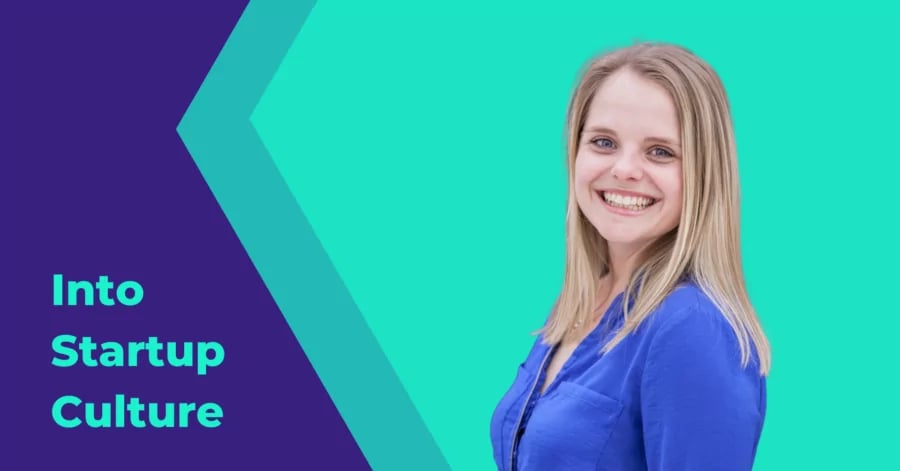Evelina Prodanova is interested in the way people make organizations successful. She has a PhD in Organizational Psychology and is currently a Site Program Manager at the Uber engineering site in Sofia. Her professional interests are around culture and effectiveness, the correlations between both and the power of people.
As the organizational culture continues to be an intriguing construct and is seen as a dominant factor in building organizations, more founders are dedicated to start making things right from the beginning. In an article focused on “the right type” of company culture for startups, we explored the differences between the general 4 types. A 2019 study conducted among Bulgarian startups showed that the most common types that early-stage startups usually develop are the Clan (which resembles a family) and the Adhocratic type of culture. The first one values shared goals, empathy, and teamwork and the second one encourages creative out-of-the-box thinking. However, in order to make it in the real world, a Market type of culture needs to find its way in as well.
The idea behind this research was to identify whether specific types of culture are correlated and lead to a company’s effectiveness and productivity, which ones and if not, what startups are better off doing to get over that 5-year critical mark and become successful companies.
Here we will outline practical ideas on how to achieve a cohesive culture combining the characteristics of a Clan, Market, and Adhocratic type (organizations who are action-driven and focused on winning), while keeping a pulse on the innovations and acting fast as the environment your startup grows in, requires.)
Transparency and full alignment
The vision, values, goals, tasks, and activities that are developed at the company level should properly meet the needs of the company at the current moment. At the same time, when they are being planned it is important to incorporate the future – what would these events be like when there are 20 or 100 more people in the company, how would they change based on the pace of hiring? The founders and the core team must have reached a consensus on the values and norms that will guide the culture and the decision making, on the future plans and how they will be achieved. There should also be a mutual understanding of the responsibilities, the quality requirements and standards, the performance criteria. This is where transparency starts – the vision and consolidated direction should be shared openly with all members of the organization and their full consent to participate in this process should be sought. When company members are well informed and understand why the company’s orientation is changing, in what direction it is taking, and how they can be more successful if new goals are achieved, when their feedback and consent is sought, they become allies and co-creators of the desired change rather than acting against it. It is indeed very important to explain the intention and the reasons for a certain change. Before it is understood and accepted, change cannot happen without being harmful during this phase of a (young) company’s life cycle. Responsible managers need to realize that some processes require more time and to enable the team to understand and accept the proposed change. Sometimes this requires more individual or group time, a dialogue, and a discussion, and a mistake that could be made is to rush through it with the rationalization that there is no time to be wasted (often done by startups).
Although startups understand the importance of being linear and for the most part follow the sociocracy framework, accepting the fact that with the growth of the company it is necessary to set some practices and procedures as part of its daily operation will only do good. Layering by responsibilities, appointing people accountable for specific activities, and structuring them into clear chains of reporting is actually a need no matter how “corporate” it sounds. This can be relatively linear, but it is valuable to create at least one unit to become the “right hand” of management. Giving some of the first members such responsibility and encouraging them to take on some strategic key activities is a great motivating and empowering instrument.
When we talk about transparency, we do not mean that each decision of the leadership should be made with a full consensus of all employees, and/or each matter should be discussed with them. That is simply not possible. But transparency done right is connected to the evaluation, rewards and appraisal systems, the communication of each achievement, the ways that an employee’s voice is heard – all these practices need to be clear and equally apply to everyone, no matter the level.
Establishing the matrix in which the input and contribution of each member of the organization are defined, and afterwards made known to everyone is vital for creating and maintaining the trust in the company – and that can break or make a culture great.
Avoiding double standards creates sustainable internal organizational relationships that are based on a belief in equality and an honest attitude towards everyone, which are not tied to personal preferences, but to performance and effort. This moves away from the “family”, in which mistakes or careless attitude are easily forgiven, while it creates an internal bond, it is a norm for productive behavior, which at the same time supports the personal growth of those who practice it and separately guarantees such attitude to the client, which in itself leads to a strong connection with the market.
I have stumbled upon a few good examples recently – Remote, a company that is building an international payroll, benefits, taxes and compliance for big and small businesses and that was founded in 2019 has published their whole Employee Handbook, detailing all these practices and policies. It is open not only internally but also externally, together with their compensation policy. It not only creates a feeling of transparency and trust, but is a true sign of treating people equally, as well as showing respect for people’s work. Walking the talk. Gitlab, a company building a web-based DevOps lifecycle tool and one of the biggest remote companies that just recently had a (so far) successful IPO are doing the same. If you want more proof that this idea of transparency works – explore Netflix (a wonderful book on how things work there was published this year – No Rules Rules, by the CEO Reed Hastings and the Culture map’s author Erin Meyer) – radical candor is what they follow in order to create a culture of freedom and responsibility. Their very famous culture deck was one of the first efforts to showcase transparency when it was made public in 2009.
To create an open atmosphere there are a few practices that might help: having a time when everyone in a strategic role is ready to listen to an opinion, idea, hear about a challenge or problem and discuss how it can be or even how it was solved. To achieve this, key figures need to be around people, be with them, feel and experience the same potential problems in order to understand them (I don’t mean physically being around people – this is very well achieved if you are working remotely. It is about being there for team members, understanding their work, showing up and supporting them when needed). There should be no distance, regardless of the authority and responsibility, which necessarily creates boundaries easily. This means that the attitude of those who are in charge should be such that they are in both the lowest and highest position that exists in the company. Territorial or material division is more harmful than useful for creating effective communication.
In order to maintain the sought-after valuable spirit and innovative way of thinking, create an Internal innovation program. Each member of the organization participates, teams are created on a rotating basis, which for a certain period explores a process, product, team or practice and suggests how to optimize, change to achieve better results. The founders are supportive and give the opportunity to test the maximum number of proposals.
Create an internal program for learning, mentoring, mutual assistance, and sharing. Cultivating these values helps teamwork. Effectiveness at the group level is achieved by creating opportunities for having something in common, building something together – which produces positive outcomes for the company, but also helps employees to achieve personal satisfaction.
Focus on building customer relationships, make sure that employees understand why this is so important, and then give them the power to lead the way.
Pay special attention to what information comes from the customers and how it is disseminated throughout the organization. Are their needs understood in depth and do the employees know them well, do they align with them? If this is not the case, go back to talking about values and gather discussion groups to identify why there are such gaps. Analyzing and channeling that information in order to improve the effectiveness of the company-client relationship is a crucial step towards a market-oriented culture.
Make sure that employees are given responsibilities that are part of creating these customer relationships. For example, analyzing the way of communication and delivery of a product/service of a competing company would give a competitive advantage to your go-to market strategy, while it could be empowering to a group of people who know they are trusted to perform such an important task. Creating a strategic group that is responsible for monitoring and analyzing the quality of competitors’ products, as well as such that keeps a finger on the pulse of customer’s needs and their eventual change has a motivating effect as all these are vital tasks for producing a product that the market embraces. Even better, if you give the chance to someone whose role is completely different to join this team,уou might be surprised how much you (and them) will get out of such collaboration.
Leaving the voice of the customer in the hands of the employees can go even further and be even a stronger motivator – creating an improvement program or a dedicated structured forum so each member of the organization can and is expected to offer solutions to improve quality, communication and responsiveness with and to the customer, the needs of the market, optimizing a process and way of working, even creating such if one is not available.
The early stages of startups are very self-centered because of the limited resources and the variety of challenges being solved. However, identifying external organizations or even other startups that can be supported and to whose development and operation the company can contribute – according to the talent it has and the service or product – can be very nurturing for creating a culture of meaningfulness. Providing constant assistance and giving personal time to organizations whose values and activities are close to those of the company cultivates the norm of sharing and shows real caring. Volunteering in this sense contributes to creation of cohesion in the team and the idea of a Clan-type “family” culture is transformed to a more productive one.
How do we mix it all together?
Despite the focus on the customer and the market, this should not happen at the expense of the attitude and attention to the members of the organization. They are the ones who build it and are the only ones who can make it successful. I used to work for a company whose motto stays with me to this day and I find it pretty true for each organization – “We build people. And these people build great companies.” Despite the understanding that it is right to invest in market development and despite the importance of this process, investing in employees is no less important and as revenues increase, it is necessary to set aside funds to ensure what is most valuable for the team – be it benefits, more free time, additional trainings or participation at events, conferences – let them have access to what they want and ask them what really matters to them. The feeling of enough opportunities for personal development should not be neglected and the focus should be mutually distributed – looking externally to the markets and internally – to the people, when any programs and strategies are being rolled out.
And lastly – stop bragging about hustling and get some sleep. It is a common and deeply rooted belief that each person who is either part of or is a leader of a newly formed venture must go through sleepless nights and have no personal time. Despite the “modernity” of the world of start-ups, stimulating a healthy work-life balance ensures longer and more productive participation of company members. Processing and occupying excessive hours in work commitments leads to burnout, high levels of stress and disability. For greater long-term effectiveness, employees need to know that their personal lives are valued by founders and executives, and be encouraged to take enough time to enjoy their life outside of work. And needless to say – leaders need to step it up and lead by example.








